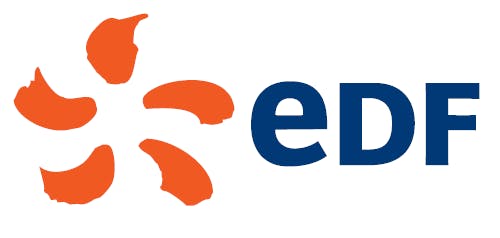HFCs are used as refrigerating fluids in air-conditioning systems. Emissions are produced by leaks during both the production process and lifecycle. All EDF group business lines are working to cut the carbon impact of the refrigerating fluids they use. As a result, the EDF subsidiary Dalkia Froid Solutions uses green fluids (CO2, ammonia, R290) for more than a third of its activities.
3.1.1.4 EDF, Europe’s biggest investor in carbon-free energy
Along with actions to manage the greenhouse gas emissions of its activities, the EDF group is investing massively to prepare for the future and build a CO2-neutral energy future. It shall be recalled that the Group’s electricity generation mix in 2020 is 76.5% nuclear, 9.8% hydro, 3.8% other renewable energies, 8.4% gas, 1.0% fuel oil and 0.4% coal(1) (see section 1.1 “Key figures”).
3.1.1.4.1 Close to 94% carbon-free investments
2020 EDF group gross operating investments totalled €16.5 billion. Based on these figures, the Group is by far the biggest investor in the energy transition in Europe, accounting on its own for more than 25% of industrial investments in the electrical sector(2).
Overall, nearly 94% of EDF group investments in 2020 contributed directly to creating a carbon-free economy, whether through investments in carbon-free production facilities (renewable, nuclear), renovating electrical networks, deploying smart meters or developing energy services.
3.1.1.4.2 Doubling of installed renewable energy capacities between 2014 and 2030
The EDF group is today the biggest renewable energy producer in Europe, with production in 2020 of 68.7TWh of electricity and 8.6TWh of renewable heat through hydroelectricity, wind turbines, photovoltaic solar power and other renewable energies.
In accordance with its CAP 2030 strategy, it set itself the goal of more than doubling its installed net renewable capacity between 2015 and 2030, increasing it to 60GWe by 2030. In 2020, the Group’s installed net renewable capacity was 33.3GWe.
Installed net renewable electricity generating capacities (GW)

2018 : 33
2019 : 32
2020 : 33
Target 2030 : 60
Key non-financial performance indicator
The methodology for this indicator is set out in detail in section 3.7.2.2 "Details on performance indicators".
To achieve this goal, the EDF group committed to accelerate its investments in renewable energies both in France and internationally, by allocating an average of more than €2 billion gross per year to renewable activities over the 2017-2020 period.
EDF was ranked in 2019 as one of the top 10 “green” companies in the world and one of the five most dynamic European companies in terms of renewable energy development(3).
3.1.1.4.3 Innovation supporting the energy transition
The energy transition requires us to explore innovative solutions and work with start-ups. This is what led EDF to set up EDF Pulse Croissance in 2017. As both an investment fund and a start-up incubator, EDF Pulse Croissance’s priority is to explore four strategic fields:
- sustainable town and country planning;
- residential services (connected home, energy conversion and optimisation, renovating homes to meet the needs of senior citizens);
- decentralised energy services (decentralised systems integrator, decentralised off-grid and nano-grid production, storage); and
- industrial performance for business customers (predictive maintenance and fault detection, industrial process improvement, fleet mobility and management, nuclear decommissioning).
See section 1.4.6.1.3 “EDF Pulse Croissance” for a detailed description of its achievements, such as the creation of the Hynamics subsidiary in 2019, dedicated to the production and commercialisation of low-carbon, water electrolysis-renewable hydrogen.
3.1.1.4.4 R&D for the energy transition
At the end of 2020, EDF R&D had a total of 1,839 employees in France, featuring 30different nationalities, and had one of the highest R&D budgets out of the biggest electricity companies (see section 3.5.2.5.8 “R&D”).
To be able to identify solutions with the lowest environmental footprints, EDF’s R&D teams work specially on analysing different electricity and hydrogen production process lifecycles. This standardised approach enables integration of environmental impacts both upstream (extraction of raw materials, manufacturing, construction of infrastructure, etc.) and downstream (recycling, decommissioning, waste management, etc.) based on multiple criteria, i.e. not only in terms of greenhouse gas emissions but also potentially depletion of resources, water footprint, waste production, protection of biodiversity, etc.
So according to the IPCC(4), greenhouse gas emissions based on a lifecycle approach for one electrical kWh produced by a nuclear facility are 12g/kWh, given that the wind turbine (on shore) and photovoltaic solar segments respectively have a carbon footprint of 11 to 44g/kWh (see section 1.5 “Research and development, patents and permits”).
(1)In consolidated data.
(2)6th European energy company financial ratings Watt’s Next Conseil, September 2020 ( wattsnext.fr/).
(3) Energy Intelligence, Green utilities report, 2019 ( www.energyintel.com/).
(4)IPCC Assessment Report 5, 2014, Working Group III – Mitigation of Climate Change, Annex III, Table A.III.2 (Emissions of selected electricity supply), medium values.
